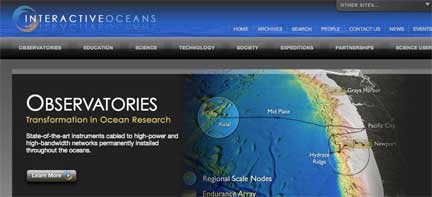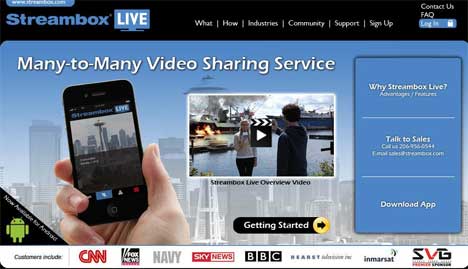
NSF Ocean Observatories Initiative Streams Live This image looks into the subsurface at Axial Seamount and shows a "snowblower" vent, a collapsed lobate lava flow about 1 meter (3 feet) across with white materials (bacterial mats and biofilm materials that coat the surfaces) thriving in nutrient-rich waters that are slightly above ambient (2 degrees C) temperature. White, dense accumulations of filamentous bacteria surround the snowblower. Credit: Canadian Scientific Submersible Facility and the University of Washington
5,000 ft. underwater in Seattle, Streambox, Inc. today announced that the University of Washington-led VISIONS’11 expedition selected Streambox 9300 Encoders, Decoders, and full platform of video transport solutions as research tools to transmit live observations of changes in the seafloor environment following the April 2011 eruption of Axial Seamount, an underwater volcano off the coast of Oregon.

The University of Washington's 274’ Thomas G. Thompson research vessel spent several days working 265 miles off the coast of northern Oregon to examine Axial. This underwater volcano is located where the Juan de Fuca tectonic plate is diverging from the Pacific plate. The VISIONS '11 team deployed the Canadian Scientific Submersible Facility’s (CSSF) underwater robotic vehicle ROPOS (Remotely Operated Platform for Ocean Science) connected via fiber optic cable to an HD video switcher that fed into a Streambox 9300 Encoder on the ship. The Encoder utilized a satellite connection to stream a 24/7 live video feed for majority of the three-week expedition back to the University of Washington campus in Seattle, as well as to the Internet for the public to view worldwide.

The Thompson was outfitted with a Streambox 9300 Encoder and 2.5-meter satellite dish to send the video from ROPOS to the Streambox Broadcast server located at the University of Washington campus in Seattle, traveling a total distance of 45,000 miles. The Streambox solution offers Forward Error Correction (FEC), which was a critical feature for this application to maintain the quality of the video content from a challenging low-bandwidth environment. The video was transported to the University where two Streambox 9300 Decoders were used for HD playout and SD web playout.

“Because of Streambox, there were hundreds of people riding along with us while we conducted this research on our journey of exploration,” said McNichol. OOI plans call for ENDS annual expeditions on the Thompson. The success of the Streambox technology in 2011 bodes well for its continued use in the project.
More information about Streambox is available at.
VISIONS '11 Related Websites
NSF:
Ocean Observatories Initiative:
VISIONS 11 Cruise:
University of Washington Ocean Observing:

